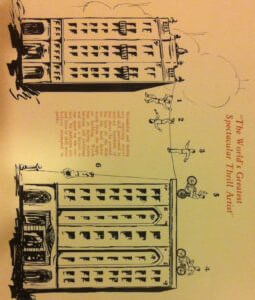 Some great TV comedy moments were achieved during the David Letterman shows when he did the top ten lists. Some examples were: “Top ten least popular Broadway Shows: #10, Oprah-homa! ,” “Top ten least-loved Christmas Stories: #9, The Sweatiest Angel ,“ and “Top ten courses for athletes at SMU: #10 Subtraction: Addition’s Tricky Pal.”
Some great TV comedy moments were achieved during the David Letterman shows when he did the top ten lists. Some examples were: “Top ten least popular Broadway Shows: #10, Oprah-homa! ,” “Top ten least-loved Christmas Stories: #9, The Sweatiest Angel ,“ and “Top ten courses for athletes at SMU: #10 Subtraction: Addition’s Tricky Pal.”
Letterman’s writers and producer must have had a strategy when creating this idea, just like a business owner should have a strategic plan when running a business. If you are a small business owner without a strategic plan, here are the top five (not ten, because we’re on a budget, here) reasons why you should have one:
- Businesses without a plan probably lack a purpose: Why does your business exist? Just to make money doesn’t cut it. Sure, we are in business to make money, but each business must also have a purpose. This purpose should infuse all business practices and should be obvious to clients. For example, if your business purpose is to bring integrated wireless technology to small businesses at an affordable price, your prospects must know that.
- Businesses without a plan probably lack a vision: Instead of dream, strategize. Dreaming is a vision with no road to the rainbow. Strategy is dreaming using realistic facts concerning yourself and your industry.
- Businesses without a plan probably lack a direction: You may think you know where you are going, but can you imagine where your business will be in ten or twenty years? Small business owners usually cannot see past the end of the month, or worse, past the next pay date. You may have a vision, but there are four horizons. Which horizon are you moving toward?
- Businesses without a plan probably lack a culture which supports change: Owners cannot change a company unilaterally. They need to foster a culture that flexes with change in the direction of the vision. If business owners cannot design a plan, they cannot communicate it to their employees, and therefore, they cannot execute it.
- Businesses without a plan probably lack meaningful tactics: If you don’t know where you are going, any tactics you establish will get you there. Businesses usually focus on tactics (how to do something), as opposed to strategy (where they are going). Therefore, the tactics are set up in a void. Just doing things, like increasing your advertising budget, is not strategic planning. There are many steps you must place together before implementing your tactics and establishing your metrics to measure them.
Small business owners must go through their own top 5 (or 10) lists when creating their strategic plans. If they don’t, the end result with be like a joke without a punch line.
(Reprinted from Money for Lunch–September 16, 2014)
https://www.moneyforlunch.com/5-reasons-why-every-business-should-have-a-strategic-plan-2/

 Have you ever baked a pineapple upside down cake? It was one of my favorite desserts as a kid. You start the recipe with laying pineapple rings and cherries on a brown sugared baking pan base. You then pour the batter over this sweet foundation before placing it into an oven to bake. When you turned the baked cake over on a plate the pineapple is displayed on top.
Have you ever baked a pineapple upside down cake? It was one of my favorite desserts as a kid. You start the recipe with laying pineapple rings and cherries on a brown sugared baking pan base. You then pour the batter over this sweet foundation before placing it into an oven to bake. When you turned the baked cake over on a plate the pineapple is displayed on top. Have you discussed something on a theoretical level with someone only to realize it was just mental calisthenics? In other words, did that conversation deal with the REAL world?
Have you discussed something on a theoretical level with someone only to realize it was just mental calisthenics? In other words, did that conversation deal with the REAL world? I recall reading Bill Gate’s book in the early 1990s about a device that will come to the market that you can use as a phone, a personal computer, a device to buy merchandise, and many other useful tools. And, it would be the size of a pocket book.
I recall reading Bill Gate’s book in the early 1990s about a device that will come to the market that you can use as a phone, a personal computer, a device to buy merchandise, and many other useful tools. And, it would be the size of a pocket book. At nine years old, my cousin Bill and I learn to sail and eight foot sailboat that his dad made. The first thing that intrigued me was that you usually don’t sail a boat in a straight line to your destination. No, you “tack” back and forth zigzagging so the the sail is always facing the wind. Yet, you had one eye over the bow, and one eye on the distant horizon that may at 45 degrees to the boat’s bow.
At nine years old, my cousin Bill and I learn to sail and eight foot sailboat that his dad made. The first thing that intrigued me was that you usually don’t sail a boat in a straight line to your destination. No, you “tack” back and forth zigzagging so the the sail is always facing the wind. Yet, you had one eye over the bow, and one eye on the distant horizon that may at 45 degrees to the boat’s bow. About ten years ago I went into my fifteen year old’s room and laid on the bed to talk to him while he was online. He told me was he had learned of this “new” music service where you can acquire music for free. It was called Grokster. After watching him for a few minutes I concluded that this was wrong behavior. I explained to him that this activity bothered me for two reasons: 1) It was stealing. He was not purchasing but “acquiring” music for free. and 2) I had music clients who made their living from selling the music they wrote and performed. I told him that he had to cancel his account and not use it. In its place, I made him and his following brothers and sister a deal. If they promised not to download free tunes, I would pay for all of their music purchased through a service. Fortunately, they did not go hog-wild and buy thousands of songs. Instead, they usually purchased the latest acts, classic rock , and jazz. Since I shared the music account with them, I was able to learn a lot about the latest acts and play jazz. The practice still lives today with child (daughter) number four, but I really don’t care to listen to Justin Bieber. Still, honesty prevailed and they learned that conventional wisdom is not always wisdom at all.
About ten years ago I went into my fifteen year old’s room and laid on the bed to talk to him while he was online. He told me was he had learned of this “new” music service where you can acquire music for free. It was called Grokster. After watching him for a few minutes I concluded that this was wrong behavior. I explained to him that this activity bothered me for two reasons: 1) It was stealing. He was not purchasing but “acquiring” music for free. and 2) I had music clients who made their living from selling the music they wrote and performed. I told him that he had to cancel his account and not use it. In its place, I made him and his following brothers and sister a deal. If they promised not to download free tunes, I would pay for all of their music purchased through a service. Fortunately, they did not go hog-wild and buy thousands of songs. Instead, they usually purchased the latest acts, classic rock , and jazz. Since I shared the music account with them, I was able to learn a lot about the latest acts and play jazz. The practice still lives today with child (daughter) number four, but I really don’t care to listen to Justin Bieber. Still, honesty prevailed and they learned that conventional wisdom is not always wisdom at all. Did you ever catch a baseball at a professional baseball game. I had attended Dodger games since I was a kid, and never even got close. The odds of catching a ball changed depending on where you sat. However, no matter how great the odds were, I would bring my ball glove. Nothing came close, except when I became a father.
Did you ever catch a baseball at a professional baseball game. I had attended Dodger games since I was a kid, and never even got close. The odds of catching a ball changed depending on where you sat. However, no matter how great the odds were, I would bring my ball glove. Nothing came close, except when I became a father. Abraham Maslow stated in 1966, that if the only tool you have is a hammer, you would be tempted to treat everything as a nail.
Abraham Maslow stated in 1966, that if the only tool you have is a hammer, you would be tempted to treat everything as a nail. Bobby Owsinski’s article,
Bobby Owsinski’s article,  My Grandfather, Louis Alfano, was Alfano the Great. Yes, all our grandfathers probably had great long tales that expanded with time, but my grandfather had proof. He would work as a tight-rope walker in the 1920s between two buildings in Chicago. When asked about it fifty years later, he would say, “Oh, don’t remind me. I can’t believe that I did such a crazy thing.”
My Grandfather, Louis Alfano, was Alfano the Great. Yes, all our grandfathers probably had great long tales that expanded with time, but my grandfather had proof. He would work as a tight-rope walker in the 1920s between two buildings in Chicago. When asked about it fifty years later, he would say, “Oh, don’t remind me. I can’t believe that I did such a crazy thing.”
